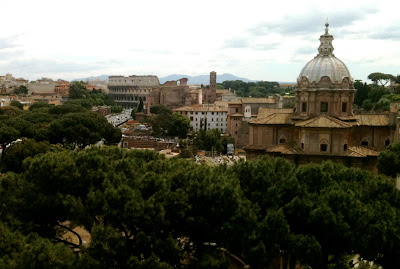
Rome contains over 900 churches filled with art, antiquities, and prior to the mid-1800's, lots of buried faithful. We had to create some criteria, quick, in order to narrow down the churches that would be important for us to see.



1. Chiesa del Gesù (1580) – home of the Jesuit order, the design of this church is a model for churches all over the world.

2. La Maddalena (1735) – between my husband’s favorite clothing shop (Cosimo Colonna, Piazza Campo Marzo) and my favorite clothing shop (Degli Effetti, Piazza Capranica). Very baroque and undergoing a lot of interior restoration work.

3. Pantheon (118 – 125 AD) – the oldest Christian church and amazing architecture.

4. San Clemente (2nd century) – this is the church EVERYONE who comes to Rome should see FIRST! As it’s an archeology site, one can venture down and explore two early layers of history – the fresh 1108 church above ground, a 4th century basilica and a 1st century BC home and Temple. One is even able to see an exposed acquaduct in action! Pretty amazing, especially for kids. The Colosseum can be seen down the street.
5. San Francesco a Ripa (1603) – built adjacent to a convent San Francesco stayed in while visiting Rome in the early 13th century. Luckily, Father Greg (Santa Susanna) was with us, so we were able to enter the room San Francesco stayed in – a very cool experience!

6. San Giovanni in Laterano (314 – 318) – the ORIGINAL Vatican. The Baptistry design (on the right) influenced the majority of future Baptristy’s in all of Europe.
7. San Lorenzo in Lucina (4th century) – had to explore, when following the Ara Pacis trail.

8. San Marco (336 AD) – gorgeous 9th century apse mosaic and stone mosaic floors. In the mid-1400’s this church was granted to the Venetians, as it’s adjacent to the very grand Palazzo Venezia, which was the Venetian embassy, and at times, a papal residence.

9. San Pietro (349 AD) – which didn’t become the current and permanent Vatican until after 1860, when the papal army was defeated by the Kingdom of Italy. I’m not a fan of this church; it’s overwhelming and grotesque, for my taste. Of course, an Angels and Demons church. The only redeeming feature: the Pieta by Michelangelo and I can't seem to find a pic, out of my 5,000 photos, it's here somewhere..


10. San Pietro in Vincoli (432 – 440 AD) – however, the foundation beneath this church dates to the Roman Republic era (509 – 27 BC). This church contains, possibly, the chains that bound Saint Peter in Jerusalem – via one legend after another – the chains have been reunited and placed in this church. We went for the Michelangelo sculpture of Moses.
11. San Sebastiano (4th century) – the church at the entrance to one of the largest catacomb sites.
12. Santa Cecilia in Trastevere (4th century) – the apse mosaic and frescos are beautiful.
13. Santa Crisogno (4th century) – Honestly, an excuse to eat in Trastevere after touring a historic church.

14.Santa Maria del Popolo (1099) – our neighborhood church filled with amazing art, of which I don't have one decent shot. However, I do have a bit of humor (at least for me) of some dead person and a confession booth covering their head. One of the Angels and Demons churches.
15.Santa Maria degli Angeli (1563) – a Michelangelo church, we love the sundial in the floor with the corresponding zodiac signs.

16.Santa Maria della Vittoria (1605) – right next to Santa Susanna, an Angels and Demons church, intimate and full of beauty.

17.Santa Maria in Aracoeli (6th century) – just out walking, stopped by. The church of the Capital – where the heads of state attend.


18.Santa Maria in Cosmedin (6th century) – for Bocca della Verita, stone mosaic floors and twisted mosaic candlestick (love those!)
19.Santa Maria in Trastevere (217 – 222) – the history, the mosaics and another excuse to eat in Trastevere!
20.Santa Maria Maggiore (5th century) – the mosaics are plentiful and breathtaking.

21.Santa Sabina (425) – one of the earliest Crucifixions in history is carved on the original entrance door. I snuck out there and took a photo. I was caught, but I wasn't arrested. Very cool.

22.Santa Susanna (4th century) – this is our chosen parish church, as it is the church for those who speak English. Many of our friends attend this church with us. Father Greg is a hoot. This is the first church where we’ve felt like we were part of a community. We’re going to miss Santa Susanna.

























